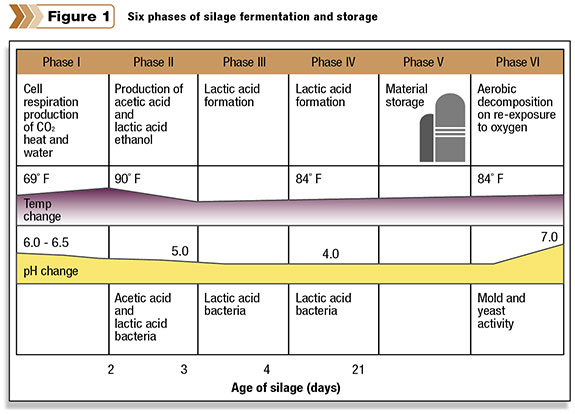Making silage is a fermentation process that consists of six phases (see Figure 1), but on many farms the last phase – feedout – is often the most neglected. This final phase of fermentation starts the day the silo is opened and continues until all of the forage has been consumed.

Consistent daily management is a challenge in any profession but especially difficult for dairy farmers who rely on employees to do the feeding.
Regardless, producers should be aware that up to 50 percent of total dry matter losses can occur during feedout, so it’s important to quantify the cost of inconsistent management.
Farmers should consider not only the nutrient loss but also the impact on the cow.
Cattle have an excellent sense of smell and taste, and these senses dominate how they behave. If silage is hot, moldy or reeks of undesirable organic acids, then they will not eat as much nor produce as much milk.
What about additives?
Recently, there’s been a lot of interest in the role of additives in keeping silage cool at feedout. Some producers add propionic acid and other TMR stabilizers to minimize heating at the feedbunk.
The goal of additives is mainly to inhibit yeasts. Yeasts are naturally present when the crop is ensiled. When oxygen is removed from the silo, these yeasts will go dormant.
However, when the silo is opened and oxygen is reintroduced, these yeasts will start to proliferate. Yeasts are responsible for a majority of the secondary heating and associated dry matter losses.
Additives are used to suppress these yeasts and thus limit secondary heating. Yeasts convert sugar to alcohol, with the byproduct of this reaction being heat.
In my opinion, using additives at feedout is a lot like putting a tarp over a volcano. While these additives are effective at reducing heat, it is far more effective to address these yeasts during the initial fermentation than to try and suppress them during feedout.
Here are three considerations for optimal feedout management:
1. Proper silo design – Good feedout management starts with silo design. The rate at which you’re feeding is the first parameter to consider when designing a silo. The silo should be built with the smallest possible exposed face.
You also want to remove at least 6 and preferably 12 inches of silage per day. This ensures fresh silage is always delivered to the feedbunk. Remember, the number one enemy of silage stability is oxygen. When exposed to oxygen, silage will start to degrade.
One way to illustrate the effects of oxidation is to think of a pumpkin at Halloween. A pumpkin removed from the vine will last for several months, but what happens when the pumpkin is carved into a jack-o’-lantern? It will rot and collapse within a few days – demonstrating the effects of oxidation.
Redesigning a silo is not always possible, so understand the effects of oxygen and try to minimize the damage by reducing surface area.
2. Smooth “facing” – Another best practice for good silage management is “shaving” the face of a bunker or pile with a loader or a mechanical facer.
The objective is to pull down the amount of silage that will be fed in one day and reduce the amount of surface area exposed to oxygen. For the most part, this practice is being adopted, but on some farms I’ve observed large gouges or cracks in the silage face.
This is a result of digging too deep with the loader or going too fast. When using a loader, shave the face from side to side rather than from top to bottom. This will result in a smoother face.
Regardless of the machine or technique you use, focus on maintaining as smooth a face as possible. Remember, it’s all about the surface area exposed to oxygen.
Finally, be sure to remove all piles of faced silage on a daily basis to minimize heating, spoilage and dry matter losses.
3. Effective silage inoculants – Effective silage inoculants reduce secondary heating by producing organic acids which lower pH levels and reduce microbial activity, resulting in a more stable feed. There are two bacterial strains on the market that further combat secondary heating.
Lactobacillus buchneri keeps feed cool at feedout by producing large amounts of acetic acid during fermentation.
Acetic acid is more commonly known as vinegar. Vinegar is a great antimicrobial that suppresses yeasts and is therefore effective at reducing secondary heating; however, there are some drawbacks.
L. buchneri is a slow fermenter, often taking 45 to 60 days for the fermentation to complete, and even when the fermentation is complete, the resulting pH will not be as low as with other inoculants that produce lactic acid rather than acetic.
This slow fermentation process can result in higher dry matter losses during initial fermentation compared to other types of silage inoculants.
Another issue with L. buchneri is animal performance. Recent research presented by the U.S. Dairy Forage Research Center indicates that homolactic silage inoculants increase animal performance by 3 to 5 percent, but the same results were not seen in the heterolactic fermenters like L. buchneri.
Another unique bacterium that has an effect on secondary fermentation is Lactobacillus plantarum MiLAB 393. This strain of bacteria secretes a bacteriocin during fermentation that has an inhibitory effect on certain types of yeasts and molds.
So when oxygen is reintroduced into the silo, the yeasts’ ability to proliferate has been greatly reduced. Since yeasts are the primary cause of heating, reducing yeast populations will reduce secondary heating and prevent dry matter loss.
MiLAB 393 is a homolactic fermenter, which means fast fermentation is achieved with a predominantly lactic acid fermentation. Furthermore, since MiLAB is a homofermenter, the animal performance boost of 3 to 5 percent is still in play.
In conclusion
Feedout management is a critical step towards achieving the most milk per ton of your homegrown forages. Designing a silo based on the feedout rate goes a long way to help with this management challenge.
Feeding fresh silage daily will reduce dry matter loss and promote feed intake. Keep the face of the silo smooth by “shaving” it. This will reduce the surface area exposed to oxygen for prolonged periods of time.
Finally, effective silage inoculants, when properly applied, will lower pH levels and stabilize the bunk life of the forage. Certain strains of bacteria can reduce secondary heating through the suppression of yeasts and molds.
Further research and development is under way with a considerable focus on reducing secondary heating and associated dry matter losses. Detailed planning, good management practices and adoption of new technologies are keys to managing the forgotten phase of fermentation. PD
Mattox is a Feedtech Solution manager with DeLaval Inc.
References omitted due to space but are available upon request. Click here to email an editor.

-
Jim Mattox
- Feedtech Solution Manager
- DeLaval Inc
- Email Jim Mattox







